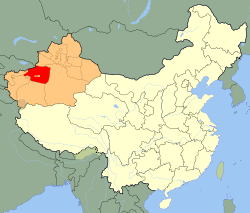Top Qs
Timeline
Chat
Perspective
Aksu Prefecture
Prefecture in Xinjiang, China From Wikipedia, the free encyclopedia
Remove ads
Aksu Prefecture[3][4] is located in mid-Western Xinjiang, China. It has an area of 131,161 km2 (50,642 sq mi) and 2.714 million inhabitants at the 2020 census whom 715,319 lived in the built-up (or metro) area made up of Aksu urban district.[5] The name Aksu is Turkic for 'white water'. Aksu Prefecture has a 263.8 km (163.9 mi) long international boundary with Kyrgyzstan and Kazakhstan.
Remove ads
Etymology
The name Aksu comes from the name of the Aksu River which is Turkic for 'white water'.[6] The name is similar to that of the nearby Zhetysu region which means "seven rivers".[7] The name of Aksu Prefecture's Onsu County (Wensu) means "ten water" in Uyghur and other Turkic languages, and 'Kizilsu' in Kizilsu Kyrgyz Autonomous Prefecture means 'red water'- all of these names consist of a descriptor followed by 'su' (river; water).[8]
Remove ads
History
Summarize
Perspective
In 717 AD, the Arabs, guided by their Turgesh allies, besieged Buat-ɦuɑn (撥換, roughly modern Aksu) and Dai-dʑiᴇk-dʑiᴇŋ (大石城, roughly modern Uqturpan) in the Battle of Aksu. On August 15, the Arabs, Tibetan Empire, and Suluk Khan of the Türgesh Khaganate formed an alliance to besiege the city of Dai-dʑiᴇk-dʑiᴇŋ (now Usi County). The Tang army, commanded by Tang Jiahui (Chinese: 汤嘉惠), allied with Karluks and Ashina Xian of Western Turkestan to alleviate the siege.[9] The Arab army faced a counterattack and withdrew to Tashkent, where numerous Arab soldiers were captured but later released upon the payment of a ransom by the Umayyad caliphs.[10] Subsequent to the conflict, the Arabs were displaced from the northern section of the Hezhong region. The Turks re-engaged with the Tang and then launched an assault on the Arabs in Fergana.[11]
Following 720, the Tubo forces advanced northward into the Tarim Basin, while the Tang army re-entered Anxi in the 740s. The Battle of Talas in 751 inflicted severe losses on the Tang army, resulting in the original four towns of Anxi falling under the influence of the Tibetan Empire and Qocho.[12] The city of Togang was reestablished under Tubo control in 790. By 840, the Qocho disintegrated, with a portion of the Qocho population establishing the Qocho Empire (present-day Turpan) as their base and adopting the Turkic designation Aksu. Following the eleventh century, Aksu commenced its Islamization under the influence of the Kura Khanate.[13] In the twelfth century, Aksu, together with the Gaochang Qocho, became incorporated into Western Liao.[14]
Remove ads
Geography
The prefecture occupies the northwestern part of the Tarim Basin and the southern slopes of the Tian Shan. The southern part of the prefecture is within the Taklamakan desert. Agriculture is only possible in the areas irrigated by the Tarim River and its glacier-fed tributaries, the Aksu River and the Muzart River. Aksu Prefecture surrounds Aral, Xinjiang.
Administrative divisions
Aksu Prefecture is divided into 2 county-level cities and 8 counties:
Remove ads
Demographics
As of 2020, 2,051,412 (80.1%) of the 2,561,674 residents of the county were Uyghur, 475,323 (18.6%) were Han Chinese and 34,939 were from other ethnic groups.[15]
As of 1999, 75.0% of the population of Aksu (Aqsu, Akesu) Prefecture was Uyghur and 23.7% of the population was Han Chinese.[16]
References
External links
Wikiwand - on
Seamless Wikipedia browsing. On steroids.
Remove ads



